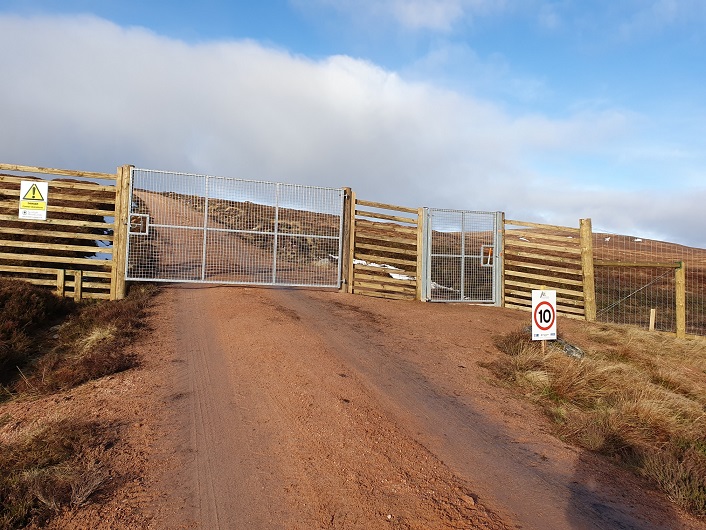
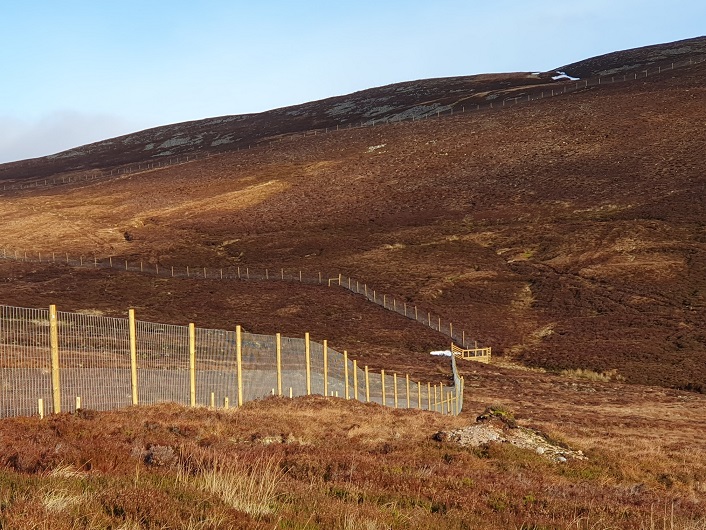
Anne noted that that there was still lots of machinery on the hillside and “The signage doesn’t provide any information (for those who are interested) on the type of work, why it is necessary and how long it will take to complete.”
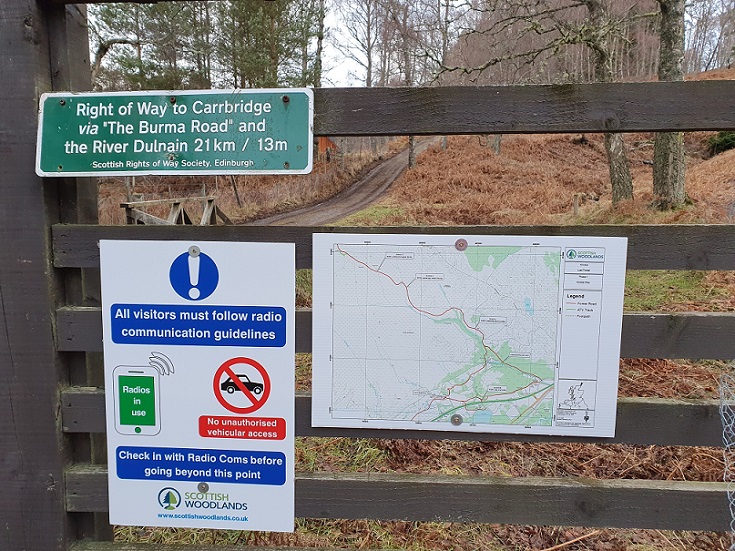
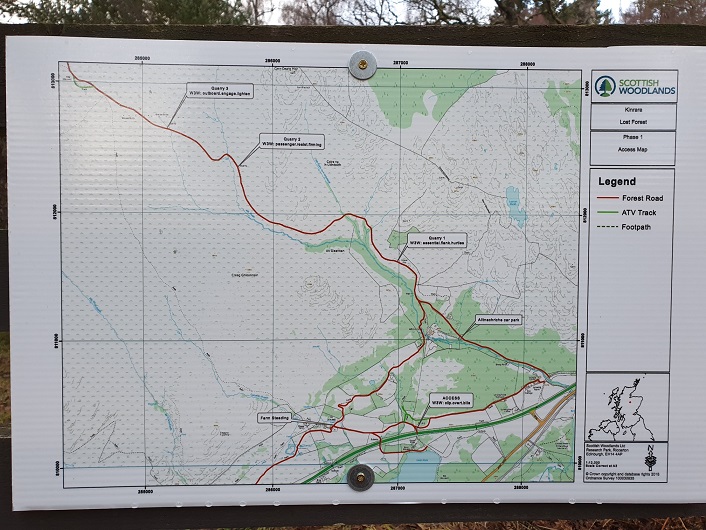
The Burma Road, a historic route enjoyed by many is now “A Forest Road” along with other tracks on BrewDog’s Kinrara estate. The main feature shown on the map is the location of quarries, though how these link to the creation of the Lost Forest is not explained.
Commentary
The Cairngorms National Park Authority National Park Partnership Plan 2022-27 aims to create 35,000 hectares of new woodland by 2045 which:
“Minimises the amount of fencing in the National Park by favouring establishment through herbivore management and removing redundant fences.”
Anne’s photos suggest the plan could hardly have made a worse start!
This fencing will have already directed yet more deer down the River Dulnain, contributing to the numbers seen there early in the New Year (see here) adding to the grazing pressure on Kinveachy where Seafield Estates are trying to enable the restoration of the Caledonian Forest by natural regeneration and without planting or fencing.
“Diverse, well-planned, climate-resilient and productive woodland will continue to generate economic and conservation benefits in the National Park. This plan sets out a direction for woodland that is about increasing areas of natural regeneration; however, planting and fencing will still be required in some places, notably those with limited seed sources and where there is conflict with herbivore impacts (especially in the early years of the plan).” (CNPA NPPP)
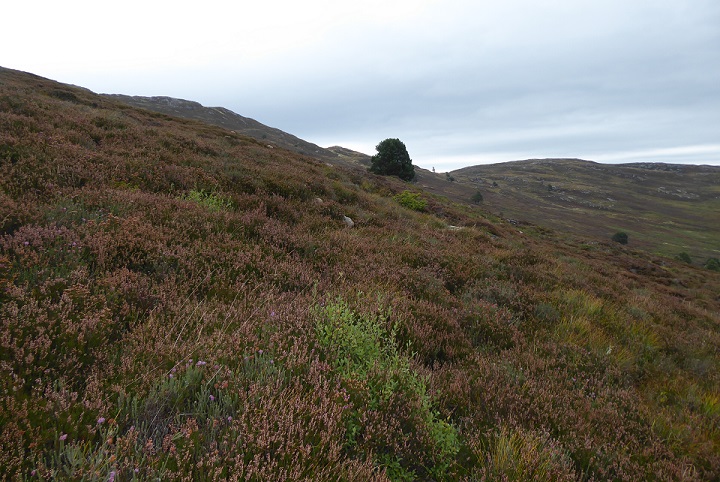
There are large amounts of seed at Kinrara, so all that is required for this hillside to regenerate naturally is to reduce the grazing pressure further but BrewDog has produced no plan to do that.
“Fencing is recognised as an important tool for woodland management but it can have negative impacts. Its use should be carefully considered and, before fencing is agreed, establishment through herbivore management should be encouraged where the surrounding land use context is favourable”
So who considered the landscape impact of this fencing before Scottish Forestry agreed to fork out over £1m in public monies to pay for it and the planting? And what herbivore management did BrewDog undertake BEFORE deciding the fences were needed?
Dave Morris will consider land-management at Kinrara further in another post but meantime it is worth taking a look at the finances.
How much is BrewDog investing at Kinrara?
BrewDog owns and manages Kinrara through a fully owned subsidiary, the Lost Forest Ltd, which has published accounts for the years 2020 and 2021 (see here). Prior to that it was a dormant company known as BrewDog Admin Ltd.
There is also information about the Lost Forest in the main accounts for BrewDog PLC (see here) which are presented with their usual punk bravado and panache
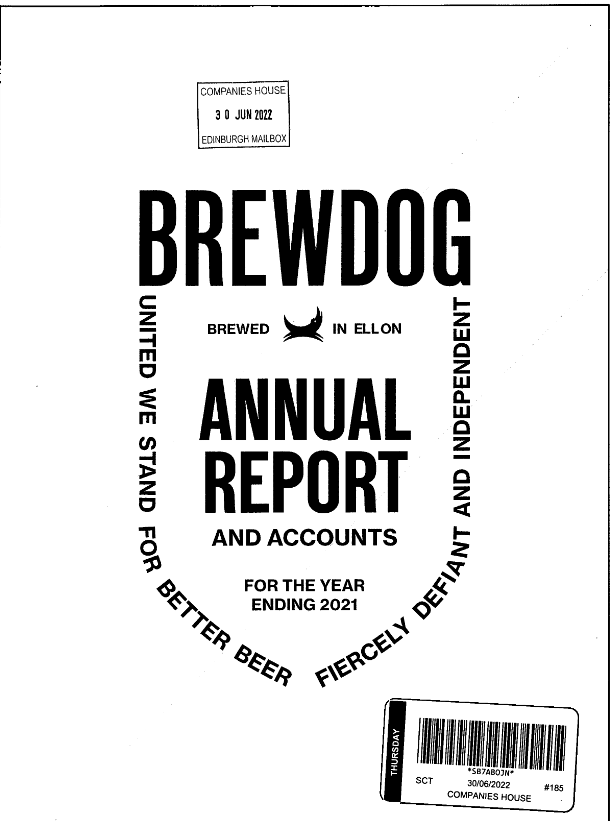
BrewDog may be “defiant” but that is not necessarily a helpful quality when it comes to managing land wisely and their accounts raise serious questions about how much they are really investing at Kinrara.
BrewDog’s main accounts till 2021 contain a thank you to their “equity punk investors” and those for the previous year reported they had raised over £25m to fund the purchase Kinrara and other green projects:
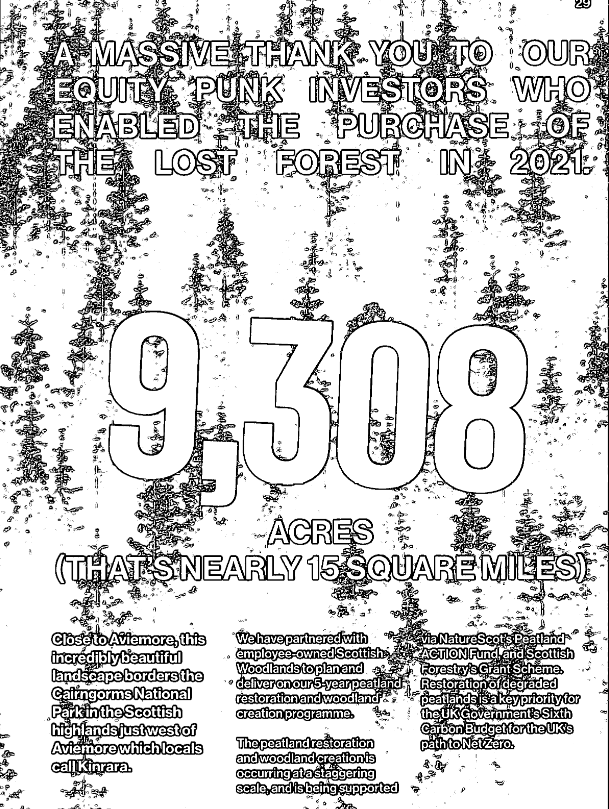
Note the acknowledgement that the actual restoration work at Kinrara is being supported by the Peatland Action Fund and the Scottish Forestry Grant Scheme. What is not stated in the accounts is how much money BrewDog has invested itself in this work so far, only that in the year till December 2020 (note 9 – link above) the Lost Forest Ltd received £183k from Peatland Action.
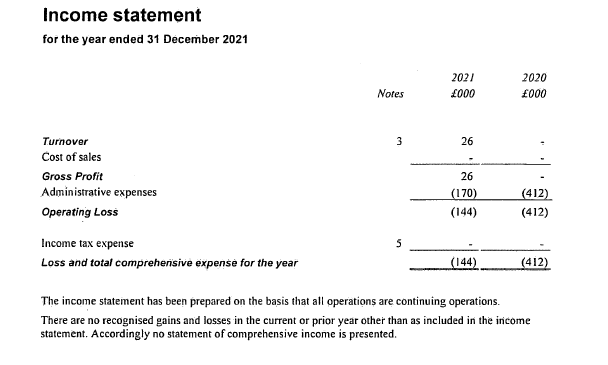
The income statement for the Lost Forest in 2021 shows very little activity and appears to support the claims made in the Guardian article last March (see here) that BrewDog was not investing what it had claimed at Kinrara:
“Early promotions for the Lost Forest suggested each can or pack of Lost Lager sold would fund a tree at Kinrara. A recent advert on BrewDog’s online store on Amazon stated “for every pack we plant a tree in the BrewDog Lost Forest”. A BrewDog tweet offering free packs of Lost Lager in January 2021, which has been taken down, included a film about the Lost Forest under the wording “we’ll plant a tree in our forest” for every pack given away.”
The money raised by investors to buy Kinrara is shown by the accounts as owing to BrewDog

It is difficult to understand WHY the overall debt of the company would be increasing, even if only slightly, if BrewDog was making a real investment in running the property. But the net effect of the debt is that the Lost Forest has negative equity, i.e. is effectively bankrupt:
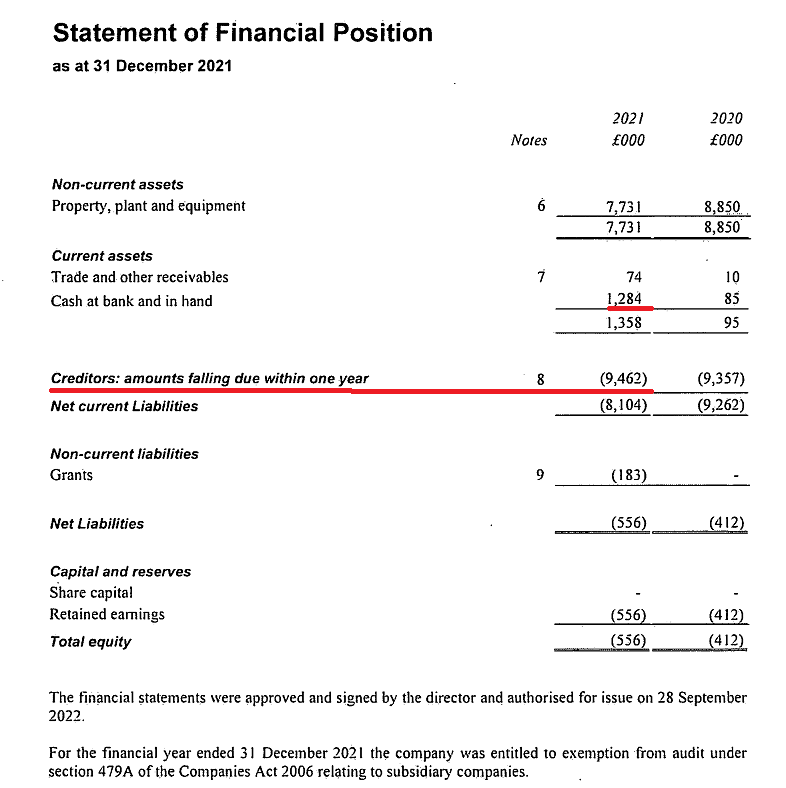
Note too the increase of almost £1m in the amount held as “cash in and and at bank”: this is accounted for by the disposal of some of the assets (property) which BrewDog bought along with the estate:
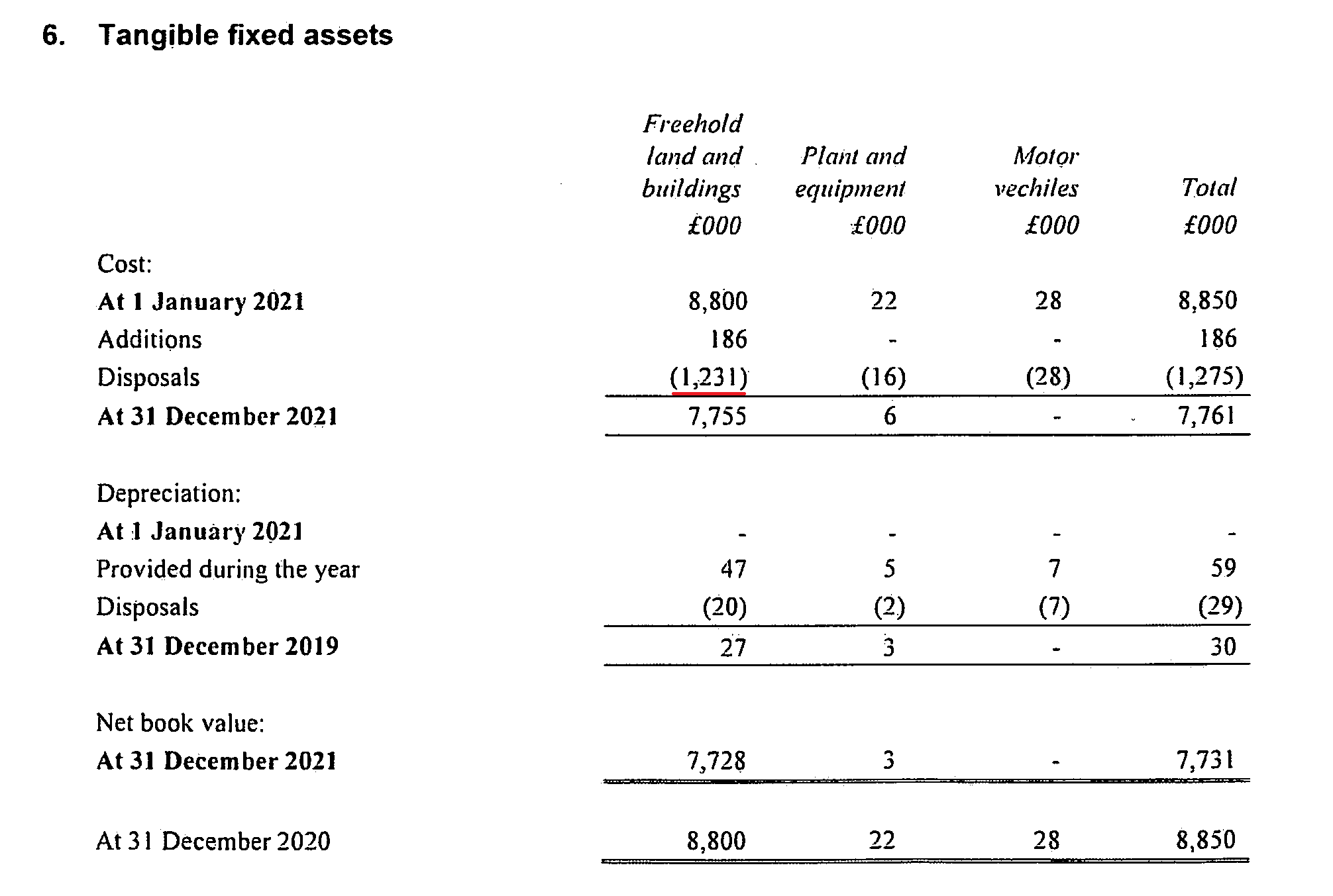
How much of that cash will now be invested in say bringing deer numbers down on the rest of Kinrara outside of the new fenced area remains to be seen.
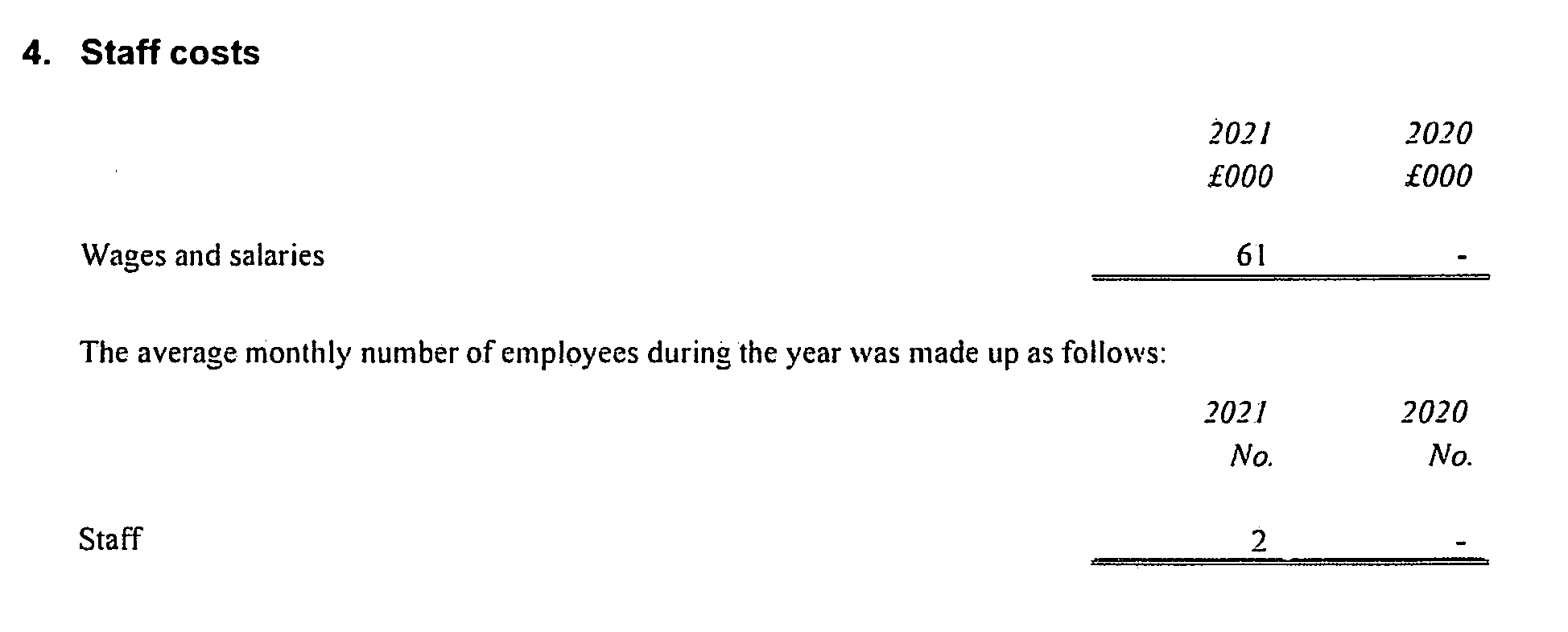
At present, however, instead of employing permanent staff such as stalkers to reduce deer numbers, BrewDog appear to prefer to pay management consultants and contractors who have no permanent stake in how the land is managed. This is causing as much damage as is being restored.
BrewDog’s main accounts claim it is investing money in a range of ground-breaking planet focussed projects including the Lost Forest:
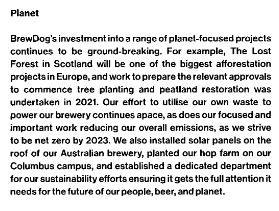
The claim is £15m will be invested in the Lost Forest:
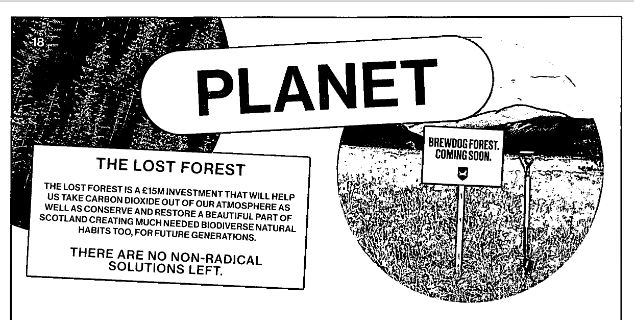
And that BrewDog is taking its responsibilities seriously:
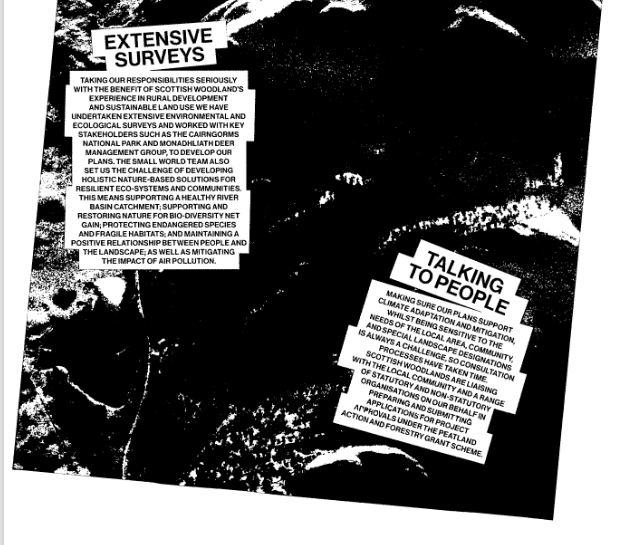
In my view the truth is rather different. As Anne’s photos show this is yet another traditional planting project, with the usual adverse impacts. It has been funded mainly through the public purse with little or no private investment. As for taking a holistic approach, BrewDog has so far avoided saying anything meaningful about what it intends to do to reduce the number of red deer, numbers of which have doubled in Scotland over the last 30 years and are the single greatest reason why woodland and peatland are in such a poor state.
Instead of tackling the real issue, the numbers of red deer, BrewDog’s fencing will direct deer elsewhere, increasing their density per square kilometre and increasing the impact of the natural environment still further.
Far from creating “resilient communities” the Lost Forest has employed just two people. A permanent forester and a team of deer stalking staff would have made a good start but having sold off property, there would now be nowhere for such staff to live. If BrewDog wanted a model for how large landowners might benefit the natural environment and the local community they did not have to look far: Wildland Ltd, who have done so much to enable woodland to regenerate in Glen Feshie, without fencing and created new jobs in the process, bought the big house at Kinrara which now serves as their headquarters.
Update 10th February – comments on post and on parkswatch
Having written about BrewDog’s purchase and plans for Kinrara on several occasions, I was surprised and delighted by the amount of coverage on social media. While Parkswatch is not trying to compete for audience, there is no point trying to analyse what is going wrong in our National Parks if no-one reads it. The post has received a record number of comments, many of which add to the debate, but some of which also express people’s feelings. I think its important that both BrewDog and the powers that be see are aware of that feeling but some of the commentary has now become personalised. I have therefore decided to resume my normal practice on parkswatch and not to approve further comments unless they meet reasonable standards of civility. My apologies, I allowed some of the comments to go too far.
Can you please tell us who Anne Weir is and what her credentials/expertise is? Can you please confirm the author approached BrewDog, Cairngorms National Park Authority and the Forestry Commission for comments and what their responses were? For transparency, I am a BrewDog shareholder supporter and I am a reporter. I write on environmental matters and I would have expected some sort of fencing to be used, possibly temporarily in creation of this area, wouldn’t you? Unless any kind of reportage approaches both sides of a story and asked them to comment, it’s merely speculation not journalism. Thanks for letting us know.
Anne Weir sent parkswatch photos – something I encourage readers of parkswatch to do – and most of the commentary is mine. Her “credentials” is none of your business or mine, people have a right to be concerned about what they see and I really appreciated her sending the photos. I am not a reporter, I am a campaigner – there is a difference – but my experience of trying to approach large landowners is highly variable – eg I have tried contacting Balmoral on several occasions and never got an acknowledgement. But I am always pleased to talk to people and if, as a shareholder supporter, you can facilitate a meeting with James Watt at BrewDog I would be delighted. As an environmental reporter I note that “you would have expected some sort of fencing to be used” – really? Have you been to Kinrara or Glen Feshie? If not, I would be pleased to show you around, point out the natural regeneration spreading up the hill by the Burma Rd and also by the old pines on the Dulnain showing that there is no need to plant (incidentally if you are not aware planting, by disturbing soils releases carbon in the atmosphere). I would also be very happy to show you Glen Feshie where the Caledonian Forest is regenerating without any fencing at all because deer have been culled. So, no, I would not expect anyone really committed to conservation on a landscape scale to use fencing – there is no need if deer numbers are reduced.
Hear Hear Nick
I wouldn’t pay too much heed to Ms Kelly’s ‘journalism’ credentials. The company that flew her to Ohio after she ‘won’ a competition no self-respecting real journalist with an interest in objectivity would go near. https://aberdeenvoice.com/2019/03/my-brew-heaven-brewdog-takes-flight/
Or there’s her puff quote supporting their AGM https://aberdeenvoice.com/2016/04/brewdogs-2016-agm-mixes-business-pleasure-perfectly/
Choosing to attack a campaigner rather than listen to their point of view and investigating is outrageous.
Brew Dog is doing an wxcellent job, ig provides badlh needed jobs. I dont knos ehy its continuslly knocked by the edtsblished media, but hood luck to them
There is far to much tax payers money wasted on giving grants to landowners to “manage” their estate.ie do nothing. In addiition to many people want rural Scotland to stagnate. I thing about 15% of Scotland is designated as a site if special sientific interest.
Spelling??????? I dont understand your post
Looks like you’ve been over indulging in Brewdog’s product !!!
Well said Nick
Well said Nick.
You are correct, this is not journalism as it is defined today which as you point out consists of regurgitating press releases and prepared statements from involved parties.
That’s why we are here, not consuming the mainstream media. I stopped buying newspapers when I realised I was paying to read lightly edited press releases from corporates, governments and pressure groups which they give away for free.
This becomes obvious when you read the same story in various places and large chunks of it are word for word identical.
We live in a brief period where it is possible for ordinary people to get out and report what they see to others, which is why there are moves worldwide to ensure that only approved narratives are disseminated.
Stay in your 15 minute zone and believe what you are told like a good citizen.
I would have expected a reporter on environmental matters to be familiar with the debates around the use of fencing in woodland restoration.
Well aware and seen your bias plastered all over Facebook and Twitter. Certainly you are a journalist as you’ve got an agenda, one which involves getting as many BrewDog brownie points as possible. Shock horror the journalist who regulars a BrewDog bar defends them blindly
More poorly understood questions, clearly it would not be in any corps interest to be found employing shooting to cut down deer numbers, and the quickest way to regenerate a forest would be to exclude deer, the fencing can be removed in 10 years as the growing points should be out of reach of hungry mouths.
The other point that the quantity of deer exceeds the lands support is not valid as the deer will eat anything they can chew, shooting and eating them is the best solution
I think if we’re going to put up a protective front ,as you clearly have a vested interest in brewdog and before stating this you could have forwarded your evidence to the contrary of what’s been stated. I’m afraid there are far too many companies out there green washing and even more muppets uneducated and believing them . It’s going to be the next big scandal me thinks
As a contractor with 26 million successful, growing ,fully established trees I have come across many environmental opinionated speculators in my time .
The great shame in these opinions is that firstly deer and hare will decimate a large number of trees,secondly mounting, or ground preparation is currently in debate and I will say this ,’there is no substitute for naturally produced nitrogen from an upturned mound ,which rots in the heat ,the tree roots sense the presence of this naturally formed fertiliser and grows straight to it.It also serves as a great combatant against weeds which is far superior to using chemicals to treat unwanted tree choking vegetation.The issue of carbon release from ground preparation versus the amount of carbon sequatered from actual growing stems is second to none in the long term.These are points omitted by none of the replies on the post here ,however I’m not sure of like myself they have lived a life of successful forestry Establishment as I have .Scottish Forestry and Land have successfully and consistently proven beyond any doubt that they can manage and indeed fulfill grant scheme obligations on private land ,a point greatly overlooked and omitted by all who so far responded..
Believe me when I say that there are far more places to look than at brewdog who ate trying ,at least to do something positive.
If you wish deer numbers to be reduced then why don’t some of these natural regeneration “specialists ” come and look at areas that have failed in the past due to insufficient or substandard ground prep and open fenced areas to allow the deer free food.
It is ridiculous that any of the aforementioned have such an unrealistic Ill informed bias which in reality has no actual fully explored assessment.
The Caledonian forest originally survived because there were enough humans eating deer and other forms of life which enabled the forest to thrive.However I wouldn’t expect a southern bloodline to understand nor appreciate the history of the Highland culture nor the reasons and effects throughout history that have brought the barren landscape to be what it is today .
Shame on ye that is biased based on your lack of true knowledge and fully aware perceptions ..
What’s the “check in with radio coms before going beyond this point” on that sign? Am I expected to carry a walkie talkie along the Burma Road now??
Similar to some of the instructions around wind farms, health and safety at *work*. I have always assumed that they are not relevant to recreational visitors.
Thanks for sharing this, Nick.
If of interest to anyone else, Andy Wightman shared this piece on the role/impact of private entities on reforestation in Scotland: https://www.sciencedirect.com/science/article/pii/S0264837722005518?via%3Dihub
An interesting quote from it:
“If you’re a big landowner… then you can kind of make money out of planting trees. The grants for woodland creation are very, very generous… It’s much harder to make the scheme profitable if it’s a very small scheme. So, communities … or individuals who want might want to plant up little areas of land, have to more or less go through the same bureaucratic process … it costs as much in terms of transaction costs… it’s not just the economies of scale that matter, but your ability as an applicant to cash flow the process… these things aren’t always available to communities”. (NGO7)
Culling deer to enable natural regeneration??? Has anyone thought that this approach is simply wrong hence the requirement for fences. Lets all go hunting to let a forest grow… sorry but this is simply wrong in my mind. If there is a real need for culling, where is the natural approach for this?
It’s not wrong. It’s common sense given deer populations.
The natural approach would be the introduction of lynx, wolves and bears as the natural predators. Humans now have to carry out those roles. Fencing is not natural. [Declaration, an ordinary member of John Muir Trust who have written extensively on this subject]
I am sorry but between the rich acquiring our land like Pokemon for their own interests until those business interests change, planting tree scams of businesses, the carbon capture scams, some (most def not all) of the dodgy conservation orgs that are more about image, trendy optics/buzzwords and their own gains beyond genuinely improving environment and engaging communities… And then the BRING BACK LYNX AND WOLVES TO DEAL WITH DEER brigade. I say this as someone who is not a fan of the unnecessary suffering or death of any living creature where avoidable and is most definitely not a supporter of killing creatures for mere amusement and sport (I grew up interacting with a lot of indigenous communities and respect for wildlife and environment is important but as is balance) , however, there IS an ecological balance required and we as a species aswell as other creatures have historically been involved in that… sadly we have also disrupted that balance significantly and whilst some seem to believe the tropes that lynx and Wolf will aid us currently re deer, I just put my head in my hands… have you seen the state of wildlife in the U.K. inc Scotland? Have you seen the attitudes towards existing wildlife, inc but not limited to birds of prey, beavers, and so on? Have you seen the state of our land albeit there have been many great projects boosting areas and esp the Caledonia Forest? Culling deer to keep numbers sufficient enough to have these amazing and iconic creatures that also have their purpose but also ensure habitat is restored and healthy by deploying stalkers makes more sense sadly, than introducing lynx and Wolf which I’m sorry but anyone minus the naive or the business PR spewers can see is a terrible idea AT THE MOMENT for those creatures. We need more work in order to create a better starting point for reintroduction, aswell as ensuring more education and work done In order to ensure this isn’t yet another failed vanity project to appease some. I completely support introducing apex predators even tho it’s unpleasant for the deer, it’s natural, BUT, right now is not good for wildlife, inc those apex predators given the current state of affairs. And I say this respectfully but we have to be realistic, we have more work to do, and rolling up sleeves and doing the basics is needed first in my opinion.
Deer populations are far too high in Scotland due to having no natural predictors as well as their historic link to land value. Their over grazing damages the land and prevents regeneration/reforesting. Fencing to keep them out means there are even more deer in the surrounding area, putting pressure on a delicate habitat. Culling is about herd management not removing the entire population, and is essential land management in the Highlands.
Nick – well done. It’s ironic that the wildland HQ is set in the midst of it all. Worth emphasising that in this area there has been more effort than elsewhere in Scotland to afforest land without fencing – and as you point out – that by erecting this fencing they are simply making the problem worse for others. Lastly – surely BrewDog must have submitted a Management Plan to Forestry Scotland for approval. – Did FS simply nod it through – surely not…..
Thanks Alan, both I and Dave Morris submitted comments on the plans to Scottish Forestry but they appear to have made no difference. Unfortunately, Scottish Forestry’s system for commenting on management plans is far more opaque than the planning system for all its faults! Nick
Hi Nick – Yes the system is awful. I had a to and from with Dingwall about three years ago and eventually complained to the boss and he came back to me apologised and got his staff to send me the full plans (not this site ) – which are supposed to be available to the public. Maybe you should email him.
I get that you have a number of legitimate concerns, but a lot of the issues you highlight are definitely not as black and white as you point out.
I have recently embarked on something similar (albeit on a much smaller scale!) and assuming the process is the same. BD would have had to engage an independent forestry expert to produce an extremely detailed management plan for what they wanted to do over the next 15 years, what type of trees were getting planted, density per acre, proposed fencing and a wildlife survey, this would be submitted to local authorities for approval. You can’t just plant trees or cut them down without permission – the environmental impact would be assessed as part of that.
Yes, introducing wolves and Lynx would be great, but that isn’t something that you can do now, so until this is even possible, its not relevant to this.
Yes Deer fencing isn’t ideal, but it is still the standard way of protecting young saplings from browsing and the plan will often be to remove this when the forest is established. Yes you could go shooting lots more deer, but again this isn’t always going to go down well with neighbouring landowners and for a place that promotes plant based foods you can see why a mass Deer cull isn’t great optics for the company.
Yes, you can just fence it or protect it and hope the forest regenerates itself but planting kick starts the process. Even well respected pioneering organisations like trees4life plant lots of trees, so its a strange criticism.
“Abuse of public money” my experience has been that there are lots of grants but they don’t cover anything like the total costs involved. Anyone who undertakes these projects would apply for this money, why wouldn’t you ? Its an incentive to hit rewilding / foresting / co2 targets. Has everyone who has applied for a grant abused public money? Seems a bit dramatic.
“A landscape disaster” planting lots of native trees on barren hillsides that used to be forest, strikes me as anything but…Interesting read though and the comments as well!
There are responses to all these points.
– Yes, BrewDog did engage consultants, Scottish Woodlands, did those surveys and have done the same for over in the Dulnain where they are proposing to plant in and around a remnant of old Caledonian Pine Forest where you can see pine saplings which can eaten before they grow. There would be no need for all this expense and planning if instead BrewDog had shot the deer. The money would be much better invested in creating jobs controlling the deer
– You say the deer fencing can come down when the trees are established. That is often said but wrong. If the deer numbers aren’t reduced, all that will survive in the new fencelost forest is the trees that have got away – and I have seen deer destroy rowan 14ft high. There will be no understorey. So, deer to be controlled if you want what you say to happen and it would make far more sense to do that from the start. It does not happen because of the forestry grant system.
– It is also not as simple as planting kick starts forest regeneration. Plant lots of trees all at one you not only get an even aged forest, you promote an explosion of other browsing animals – hence the plastic tubes. BrewDog’s forest plan – the one I saw – proposed culling mountain hares but is not proposing plastic tubes thank goodness. The problem they face is there is also likely to be an explosion of voles and the fencing will, if its successful, help keep predators of those voles, like foxes out.
– People love the idea of planting trees, hence the appeal of Trees for Life, but the reason they have had to plant and fence around Glen Affric is all to do with neighbours failing to control deer numbers.
My overall point is Scotland has a really serious deer problem, bad for the rest of nature and bad for carbon emissions, and instead of tackling that over the last 30 years it has got worse. The money spent on forestry grants would be much better bring deer numbers back down so the rest of nature could do its work.
I read an article (link below) that suggested the initial outlay for this is around the £9 million mark, with £1.25 million being grants. It sayd that 100+ deer were culled prior to fencing, it doesnt mention though if deer culling is to be continued as part of the plan.
I guess what I’m saying is that if big companies want to invest in Scotlands countryside for rewilding or native forestry, call it greenwashing / green lairds etc, but for me it is way preferable to having huge hunting estates with virtually zero plantlife and the persecution of raptors, golden eages etc that seems to go with it. One of the reasons this area is so devoid of trees is because thats exactly what they used this area for previously.
I think we all share a similar end vision but just differ on the route to getting there.
https://www.edie.net/carbon-sequestration-and-rewilding-inside-the-lost-forest-being-built-by-brewdog/
Most of that outlay was to buy the land and was raised from shareholders. BrewDog has never as far as I am aware answered how much of the money it raised from drinkers who bought its bear thinking it was being used to help plant a tree has actually been used to plant trees. Perhaps the next accounts will reveal more but for the last financial year what little work was being done on the estate appears to have been financed by the public purse, not BrewDog. I agree though the fact that BrewDog has stopped muirburn and grouse shooting by all appearances is a very good thing. It will help the land to recover. The sad thing is they have then decided to plant trees, when there was no need, instead of culling the deer. So, while they are better than most sporting estates, they are well behind Wildland Ltd, NTS and Cairngorms Connect and that needs to be said publicly.
I am no fan of BrewDog, however you are misinterpreting their company accounts. Every limited companies must balance, in that assets/cash etc must equal the value of the shareholdings, which you are misinterpreting as a debt.
So if my company has £1000 in the bank, and a tractor worth £4,000, there will show a -£5000 which is in reality representing my ownership.
And investment in an asset certainly wouldn’t be on their income statement!
Tim, sorry for delay in replying, was reminded of my failure to do so and responded to Neacaill above. You are right about accounts having to balance of course
Thanks Nick & Anne for bringing ging this to attention. I use this track and hillside on a regular basis and have seen the work of fencing since last Summer. As we’ll as all that has been explained by Nick I have noticed so many disgusting tracks created by large plant machinery going across the hillside and even over the shoulder of Carn Ban Mor at an altitude of 750m. Presumably a ‘short cut’ for the contractor to get down to the other side of the hill. I’ve sent some photos from the last few months.
Just saw the fences last night. Use the route reguarly for my dogging activities and this has been a massive inconvenience. Was walking along the path way my burrito in hand ready for a fun a night and next thing I know my tadger was caught in the fence.
Not only is this an eye saw, a disturbance to a great walking route but now I’m out the kennel game for a week or two and my scotch eggs are bluer than the scottish flag. No transparency no notice, but as a beewdog shareholder I expect no less from them. Been to a few dogging meetups after the bewsog festival in popular spots to meet other shareholders for a bit of peppering and the areas were also blocked of. Leaving me hanging there with no bun for sausege.
Entire article is just a winge with some numbers thrown in to make it look like anything akin to investigative. Car crash of an article.
Have you walked around Kinrara or cycled over the Burma Rd?
Hi Nick, reading your post, and the comments with interest.
It’s right to challenge Brewdog, and to hold them to account, as to what happens on the estate, particularly within the Park, and where public money is involved, however you have failed to show any ‘abuse of public money’, that you state in your headline.
Can you confirm if you’re accusing Brewdog of an ‘abuse of public money’, if so in what way, and how you support your opinion on this?
No, I am not accusing BrewDog of abusing public money, they are using the rules to get what they can from the forestry grants system (all quite legal) and it is that system which is an abuse of public money. BrewDog, however, did not have to play that system and could have challenged it as Wildland Ltd just across the A9 in Glen Feshie have done by refusing to take public money for deer fencing. Where BrewDog is concerned, there are nevertheless questions about the abuse of money which relate to what they have claimed they would invest in Lost Forest. What my article is arguing is that the evidence to date – it may change in future accounts – that almost all the investment has come from public money not what customers handed to BrewDog when buying beer thinking it was going to be used to plant trees. BrewDog in my view requires to be transparent about this.
Nick, many thanks for clarifying the context of your ‘abuse of public money’ headline, however your response raises more questions.
In comparing/ contrasting Brewdog with Wildland, could it be they have different approaches, because they have different aims to what they are trying to achieve on their land?
Both are being transparent about their aims, so the differences are clear to see, no?
You talk about ‘the evidence to date’ but as others have pointed out, you have misinterpreted the financials and you haven’t responded to their comments on this.
From the available accounts, the only public money mentioned is receipt of £183k in Grants for the peat restoration, how much do you think Brewdog has ‘invested’ or spent on the project in the same period?
How much is it that you think Brewdog have claimed they would invest, in Lost Forest?
What do you think Brewdog customers understanding is, of how them buying beer is going to be reflected in planting trees?
What is it that you think Brewdog aren’t being transparent about?
Hi Nat, yes you are right that the stated aims of BrewDog and Wildland Ltd have a different emphasis, BrewDog’s focus is more on carbon offsetting, Wildland Ltd’s more on restoration of nature. The point is though that letting nature restore itself through natural regeneration is almost certainly the best way of mitigating carbon emissions (whereas planting trees – which Wildland Ltd did for a time – releases carbon from the soil and has lots of other adverse impacts). That is why BrewDog should be learning from Wildland Ltd but instead they have turned to the forest industry. Many people in forestry of course know all this is wrong but they have to earn a living and they are driven by the grants system. By taking those grants for fencing – and we know over a £1m has been committed so far – BrewDog is sadly endorsing the current system.
In terms of the accounts, the most important point is the accounts for the Lost Forest Ltd to date do not contain clear information to show what BrewDog has invested in Kinrara, apart from the purchase of the land, but it appears to be relatively little. The plans for grant submission to Scottish Forestry showed that Deer Grids and Stiles over the fence were not funded so assuming these are installed we know that BrewDog will be making some contribution. If you know how much BrewDog invested in Kinrara for the year the accounts appeared or has invested since please let me know so that that everyone can know how much they are investing compared to what they are receiving in public grants.
I did not explain the debt very well. The Lost Forest Ltd was set up with capital of £1 but appears to be the owner of Kinrara because it has assets in the form of property of £7,731. I say appears because the transaction has STILL not been processed on the registers of Scotland where the estate is listed as “Ballinluig farmhouse” . The money used by the Lost Forest Ltd to fund the purchase therefore appears to have been provided by BrewDog as a loan rather in the form of share capital. Either method of financing subsidiaries is perfectly lawful and HIE for example has used both at Cairn Gorm. The person who commented therefore was quite right therefore that in accounting terms it was right to show this money as debt, accounts do have to balance and given the money to purchase Kinrara was raised by a share issue from the parent company this may be the appropriate way to have done this although this gives a much greater degree of control to BrewDog than to its shareholders and raises other issues which I may consider when the next accounts appear but let’s hope that public pressure persuades them it would be desirable to provide more than the mininum accounting information so that there is complete transparency about what money is being invested by whom etc
Sorry had to post this as a new comment, gremlins, I know it makes the thread untidy.
Thanks for responding Nick.
I understand Wildland and Brewdog use the same consultants, does that not provide opportunities for shared learnings ?
It’s also my understanding that Government Policy/ Grants incentivise the planting of trees, to meet a Government target, but don’t treat natural regeneration in the same way. Am I correct in this ?
As you suggest, its understandable behaviour is driven by the Grants System. Brewdog engaging with it, isn’t endorsement, unless you have an example of Brewdog publicity declaring their approval or support of the grants system?
From the reporting I read last year I understood that the forestry grant applied for, £1m-£1.25m, if awarded, was to be spread over several years and subject to conditions. Is this not the case?
Is the Grant of £1m ‘for fencing’ you refer to something different?
Also can you tag a link to this as I couldn’t find anything online that stated what grants Brewdog had actually received other than the 2021 Peat Grant, of £183m, in the accounts.
My knowledge/understanding is only from what I read in the published accounts, but it appears that you and I interpret things differently here.
The accounts period covers up to December 2021, a full ten months before any planting commenced. A period of surveying, applying for permissions, and grants, with phase one of peat restoration starting towards the end of this time.
When others have commented on the the sums Brewdog has invested, your response is that this ‘was raised from shareholders’, that maybe the case, but it’s still Brewdog’s money that they have invested/ spent.
Your statement that the Lost Forest ‘is effectively bankrupt’ is factually incorrect.
Running it at a loss with the support of the parent company doesn’t make it ‘bankrupt’, in fact it shows the money Brewdog is committing to Lost Forest.
The income statement shows a loss of £556k and appears to show £186k of purchases of capitalised items, obviously these total far in excess of the £183k Grant money received in total to the end of 2021.
Its misleading when you say ‘that almost all the investment has come from public money’, only £183k has come from public money in this accounting period.
If I’ve misinterpreted these numbers, I’m sure someone with a greater understanding of company accounts can correct me and tell us what these items are.
I’d asked you what it was you thought Brewdog weren’t being transparent about, you didn’t directly respond to this, stating you were looking for ‘complete transparency about what money is being invested by whom etc’.
If you want more detailed financial information, than Brewdog is required by law to provide, you could always buy a share, and write to the FD or table a question at the Agm.
I also asked the following two questions.
How much is it that you think Brewdog have claimed they would invest, in Lost Forest?
What do you think Brewdog customers understanding is of how them buying beer is going to be reflected in planting trees?
Any thoughts?
Thanks
Hi Nat,
Thanks for your interest. Perhaps you should be addressing these questions to BrewDog rather than me, could buy a share as you suggest I do and raise these matters at their AGM? I have put that back to you because that is my basic point, there is a complete lack of transparency in the unaudited and statutory minimum accounts for the Lost Forest. The failure in the transparency is also on the government side as you will know if you have ever tried to get information about conditions attached to Forestry Grants. In my view there is a simple solution to all this lack of transparency and it lies with the Scottish Government. The forestry/agricultural/peatbog grants system should be made far more transparent but also require that recipients publish full accounts and not just the minimum required by law. Until that happens the definitive answers to the questions you ask will not be possible.
On your questions about forestry grants, I have touched on this in previous posts – including on Kinrara – and have not the time to respond to now. I will try and do a further post on this but suffice to say WildLand Ltd is now being paid for the outcome of natural regeneration – the grant effectively helps pay for reduction in numbers of red deer instead of fencing – and BrewDog could have asked for the same. They could still do so for Phase 2 of the Lost Forest instead of planting around remnants of Caledonian Forest.
Other questions you are asking are in my view unreasonable – eg do you know what BrewDog Customers understanding was of how buying a beer would help plant trees at Lost Forest? I doubt even BrewDog knows but the point is that BrewDog put out publicity suggesting that by buying certain beers customers would be helping to plant trees at the lost forest, publicity which if you read the Guardian article was later withdrawn. Perhaps that money is represented by the £25k in the income statement for the accounts for 2021 (which also presumably covers income from any leases)? If so, it is not much compared to the £183k received for peatbog restoration (which confusingly for me at least is not in the income line). It is possible the lack of any evidence of investment from BrewDog last year is because they were still at the planning stage and they have held back planting monies raised through beer sales in the parent company.
The 2020 accounts show no income, that BrewDog spent £8,800,000 buying Kinrara and that by the end of the financial year Lost Forest Ltd owed £9,300,000 to their parent. That suggests BrewDog spent £500,000 on Kinrara in that financial year although a significant amount of this is likely to be due to the costs of purchase. You cannot tell how much was spent on ecological restoration BUT – and this the key point I made about debt – whatever that amount it is shown as a debt to BrewDog. If BrewDog had been donating proceeds from sales to Lost Forest I would have expected that to appear in the income statement where it would have offset some of the administrative expenses. Given that the cost of purchase of Kinrara was met as I understand it through a share issue by the parent company, it is in accounting terms quite reasonable to show that as a debt to the parent company. But in my view treating the running expenses and any investments at Kinrara as loans raises legitimate questions as to how far BrewDog is really investing customers money in ecological restoration and means I stand by my view that the main monies being invested in Kinrara are public grants.
If you can find information that shows this analysis is wrong I would be delighted to see it/be made aware of it. However, I hope you will understand if I don’t spend lots more time trying to answer lots of detailed questions to which, as I have tried to explain above, there is no definitive answer. We would not be having this discussion if BrewDog was more transparent and I would hope you support the need for that.
Hi Nick, thanks for responding, you said……
‘I stand by my view that the main monies being invested in Kinrara are public grants. If you can find information that shows this analysis is wrong I would be delighted to see it/be made aware of it.’
I refer you to my previous comment, where I described to you that £556k and £186k of Brewdog money spent/invested in Kinrara were sums far in excess of the £183k of peat grant money that is documented, in the accounts over the same time period.
My understanding of the accounts for 20 & 21, is that based on the above numbers, Brewdog have ‘spent’ over four times more than what they have received/ were awarded in Grant money over these two years.
Looking at 22, your analysis is ‘wrong’, to use your words, because you’re basing it on your, so far, unsupported statement that ‘over a £1m has been paid out’ in ‘grants for fences’, in an accounting period where no one has any idea what Brewdog have spent for comparison, because those accounts won’t be published until later this year.
Even if Brewdog have been paid the £1m you say they have, I don’t see how you can possibly stand by your stated view that ‘the main monies being invested in Kinrara are public grants’, when that clearly wasn’t the case in the two years 20,21, and because none of us at present know what Brewdog spent in 22, to compare to any paid grant received in 22.
Any thoughts?
I’m generally in favour of planting trees, trees in cities, parks and in the countryside and some wild places, but should we be doing this just because a business wants to continue growing and wants to continue to increase it’s pollution emissions.
Emissions reduction should be ranked ahead of carbon capture in forests when governments are issuing grants, carbon dioxide is not the only atmospheric pollution emitted during the combustion of fossil fuels, Nox emissions can be equally complicit in climate change and planting trees won’t have an impact as a sink.
There’s a place for planting forest but not ahead of actual real emissions reductions.
Hey Sam,
You said ‘There’s a place for planting forest but not ahead of actual real emissions reductions.’
Who said Brewdog are planting trees ahead of reducing emissions ?
How does 35% emissions reduction over four years sound ?
“How does 35% emissions reduction over four years sound ?” Independently verified data?
It’s a Target Keith, end of 23, there are progress updates published on Brewdog’s website.
Please indicate where their website says end of 23, because as far as I can see it actually says ” …….. by 2023 ….. “. And there is no indication that I could find of independently verified data.
Having to leave this as a new comment as I can’’t get my rely to Keith to stick -sorry.
Hey Keith, those ‘mega’ reports on their website are great aren’t they, show all the wonderful things Brewdog is doing.
By end of 23 is my understanding of it, let me explain why…..
Brewdog state they’re using 2019 as a base, can we agree on that ?
They also state 35% as a targeted reduction over four years, can we agree on that ?
So four years, 20, 21, 22, 23, do you see where I’m coming from ?
If I’ve misinterpreted that, and it’s by the start of 23, that’s even better isn’t it ?